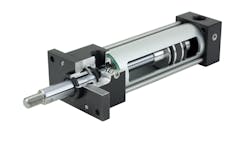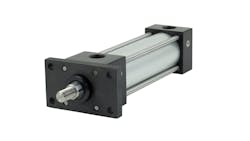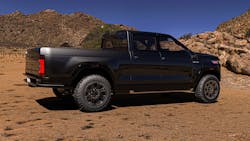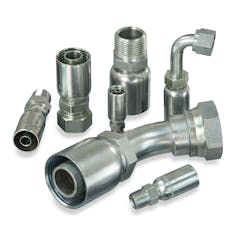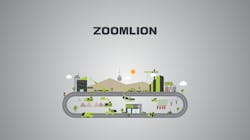This Week in Power & Motion: Festo Introduces New NFPA-Compliant Pneumatic Actuator
There is much going on in the world of fluid power and motion control from technology introductions and industry advancements to new trends and industry leaders. To keep our readers as informed as possible, the Power & Motion team has collected some of the latest news which could be pertinent to their work.
Once again, electrification and electric power systems comprised much of the news received this week which is not surprising given the rate of growth in this area for various industries. Terzo Power Systems announced the availability of its newest electrohydraulic system which aids with electrification of larger machines.
New products from Kurt Hydraulics and Festo showed there's still a place for traditional hydraulic technologies, as well. Gates and Cadence introduced new software tools to aid product development which are designed to help improve productivity and design accuracy.
Keep an eye out for a new edition each week to ensure you stay up to date on what's happening in the world of fluid power and motion control.
DOE Announces Wide-Scale Industry Collaboration on Vehicle-to-Everything Technologies
The U.S. Dept. of Energy (DOE) and several industry partners have signed the Vehicle to Everything (V2X) Memorandum of Understanding (MOU). Resources from the DOE, its national laboratories as well as state and local governments, utilities and private entities will work together on the advancement of V2X technologies.
V2X is the communication of vehicles to other vehicles or objects in its surroundings such as infrastructure like traffic lights. Integration of smart technologies within vehicles and city infrastructure is seen as a way of potentially improving traffic flow and safety, while communication with charging stations for electric vehicles could help to optimize the process of recharging a vehicle.
Vehicle-to-infrastructure (V2I), vehicle-to-network (V2N), vehicle-to-vehicle (V2V), vehicle-to-pedestrian (V2P) and vehicle-to-device (V2D) are the various iterations these communications could take, with V2X being the term encompassing all of them.
With the number of electric vehicles of all types—from passenger cars to heavy-duty trucks—expected to increase over the next decade, V2X technologies could provide many opportunities to aid with charging and the grid. DOE says bidirectional plug-in electric vehicles (EV) which can not only utilize clean energy but also feed it back into the grid or help power other things could benefit the U.S.'s energy security as well as provide revenue opportunities for EV owners.
"The MOU signed today represents a collaborative approach to researching and developing novel technologies that will help unify the clean energy and transportation sectors while getting more American consumers into electric vehicles," said Deputy Secretary of Energy Dave Turk in the DOE's press release announcing the MOU. "Integrating charging technology that powers vehicles and simultaneously pushes energy back into the electrical grid is a win-win for the future of clean transportation and our energy resilience overall."
Festo Introduces NFPA Compliant DSNB Actuator
Festo has announced the release of a DSNB pneumatic actuator which conforms to National Fluid Power Association (NFPA) standardized mounting options.
According to the company, this actuator is well suited for various applications on converting machines including sorting, stacking, insertion, loading, lifting, dispensing, clamping, and gates. The actuator is available in seven bore sizes, 11 variations and 15 different NFPA compliant mounting configurations. This provides OEMs the flexibility to use the actuator in various ways as well as standardize its part use.
Features of the actuator include a polyurethane rod-wiper seal, hard anodized aluminum cylinder, and synthetic grease, all of which help to provide a high level of performance. Long service life is assured through the use of anodized aluminum end caps as well as a high-strength steel piston rod with chrome plating, and composite rod bushing and PTFE wear band.
Toyota Investing in U.S. Manufacturing to Aid Electrification Efforts
Toyota plans to invest $383 million in four of its manufacturing facilities in the U.S. as part of its efforts to expand its electric vehicle products. Investments will be made at the company's manufacturing plants in Alabama, Kentucky, Missouri and Tennessee to enable production of engines as well as hybrid electric vehicles.
The investments will add more space and manufacturing capacity to the facilities to meet continually growing demand from customers for both engine- and hybrid-powered vehicles.
Toyota says it also plans to invest in the workforce of the future by supporting education programs for PreK-12. Doing so will hopefully help get younger generations interested in manufacturing as a career opportunity at a young age, which will be necessary if the industry hopes to fill the many jobs that are expected to be available in the years to come.
Electric Work Truck Startup Forms Partnership for EV Component Development
Startup mobility technology company Atlis Motor Vehicles is partnering with VCST, a supplier of powertrain components, to develop solutions for Atlis' electric vehicle platform. Atlis is currently developing an electric work truck, the ATLIS XT, as well as the batteries and motors which will power it.
Atlis plans to integrate VCST's e-drive gearbox products into the ATLIS XT, which the company says will help to increase efficiency and range as well as enhance driving dynamics and overall vehicle performance.
The ATLIS XT is a purpose-built, fully electric pickup truck for use in agriculture, service, utility and construction applications. It is based on the company's ATLIS XP skateboard platform featuring two identical modular drive systems at the front and rear, four traction motors and an ATLIS battery pack, in addition to other components. This platform provides the truck a 500-mile range, ensuring productivity for vehicle owners throughout the work day.
Kurt Hydraulics Expands Line of Braided Hose Couplings
Kurt Hydraulics has announced the expansion of its braided hose coupling line which now includes over 743 styles and sizes. Suited for use in various industries, these hydraulic hose fittings feature RoHS-compliant plating which helps to ensure durability and performance.
The braided hose couplings are available in SAE, metric and other end configurations to meet manufacturers' various application requirements. They can also be used with various braided hydraulic hoses such as- Kurt Tuff Hose,
- SAE 100 R1,
- SAE 100 R2,
- SAE 100 R16,
- SAE 100 R17, and
- thermoplastic hoses (SAE 100 R7 and SAE 100 R8).
Zoomlion Launches Hybrid Crane
On April 11, China-based heavy equipment manufacturer Zoomlion Heavy Industry Science & Technology Co., Ltd. introduced what is said to be the world's first hybrid all-terrain crane. The ZAT2200VE863 features a dual electric and fuel power system and is driven by a gasoline-electric dual-engine with maximum power output of 360 kW.
"Driven by policy incentives and market demand, the construction machinery industry is accelerating into the era of new energy, the ZAT2200VE863 is the latest achievement of Zoomlion's innovative product R&D. The hybrid machinery products are low in fuel consumption, pollution and noise with high energy efficiency, and it's conducive to promoting energy transformation and the technological upgrading of the industry," said Luo Kai, vice president of Zoomlion and general manager of Zoomlion engineering crane branch, in the company's press release announcing the launch of the hybrid crane.
Three lifting operating modes are available with the new hybrid crane - pure electric, plug-in and fuel power. This allows machine owners to use the best method for the application and adapt when necessary to changing work environments.
When in pure electric mode, the machine can run for 8 hours just on the battery. This enables machine owners to get a full day of work out of the crane which is beneficial to their productivity. The same is possibly when used in plug-in mode. Both modes allow emissions-free operation and eliminates the use of fuel, helping to reduce operational costs for customers.
In fuel power mode, the engine is designed to operate in an economical fuel consumption range which matches the motor the company says. This helps provide a 35% fuel savings compared to conventional diesel-engine powered cranes.About the Author
Sara Jensen
Executive Editor, Power & Motion
Sara Jensen is executive editor of Power & Motion, directing expanded coverage into the modern fluid power space, as well as mechatronic and smart technologies. She has over 15 years of publishing experience. Prior to Power & Motion she spent 11 years with a trade publication for engineers of heavy-duty equipment, the last 3 of which were as the editor and brand lead. Over the course of her time in the B2B industry, Sara has gained an extensive knowledge of various heavy-duty equipment industries — including construction, agriculture, mining and on-road trucks —along with the systems and market trends which impact them such as fluid power and electronic motion control technologies.
You can follow Sara and Power & Motion via the following social media handles:
X (formerly Twitter): @TechnlgyEditor and @PowerMotionTech
LinkedIn: @SaraJensen and @Power&Motion
Facebook: @PowerMotionTech

Leaders relevant to this article:
